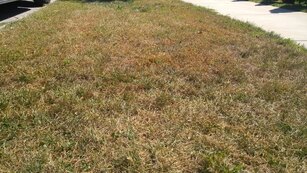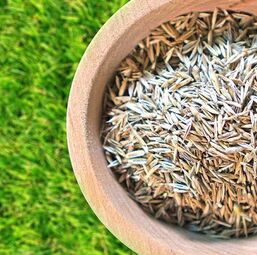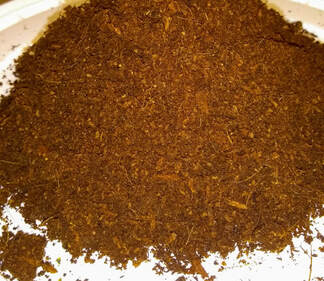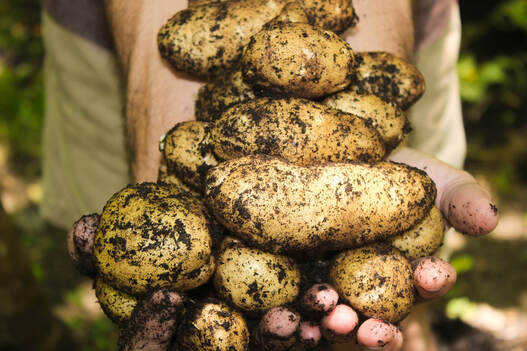 Overseeding your lawn is a really important part of having a thicker, healthier and greener lawn with less weeds. It really isn't difficult to do, but it does require some knowledge to get the most germination for your buck. Read on to learn the why, what, how, when and where of overseeding your lawn. Keep in mind, we're a West Michigan-based company, so our recommendations are targeted for this region. Why should you overseed your lawn? Nature loves diversity. On the flip side, it hates a monoculture. Our efforts, as 21st century American homeowners, to create a monoculture in our lawns goes directly against what nature wants. So, left to its own devices, your lawn is going to have a lot of diversity popping up. You might better know this diversity as "weeds." You don't want weeds (and you don't want to use herbicides)? Put down grass seed and over time, it will push out the weeds. Now you've got three options when facing the idea of lawn diversity: 1) Let it happen. Just unconditionally accept the diversity popping up in your lawn and love it as you would love a pasture growing wild in the countryside. 2) Drop chemical herbicides onto it. This is how golf courses and baseball fields roll. They put down chemical herbicides to both prevent and kill weeds. It's also how most Americans have been conditioned by the chemical lawn industry to approach their lawns. ("Weeds are BAD!") Or (our favorite choice) 3) Employ better lawn management practices. This means fertilizing with an organic fertilizer to get richer soil that turf actually wants to grow in. It means watering deeply a couple times a week to encourage deeper roots. It means setting your mower to its highest setting. And it means overseeding your lawn once, and maybe even twice, every single year. The importance of overseeding comes from the fact that weed seeds can find even the smallest gap in your lawn to germinate and establish roots. If you can put down grass seed before the weed seeds can germinate, you'll have grass growing there instead of something you don't want Now, if you're going to opt for an organic lawn, you're going to have to accept Option 1 to a certain degree. Going organic, you should always expect (and even strive for), at minimum, 10% diversity in your lawn. Anything less than that just isn't healthy. If your lawn is more than 90% grass, you're opening yourself up to pest infestation, fungal infection, higher water bills, etc. But allowing some other stuff (clover, dandelions, violets, etc.) to find a home on your lawn will help keep things balanced and healthy. And telling yourself that some diversity is good for your lawn will even help you relax a bit and enjoy your lawn more, without the stress of striving for perfection weighing you down all summer. I only recommend Option 2 (chemical herbicides) as a very last resort, and as an organic lawn guy, I don't make specific chemical recommendations. But if your yard has become more than 50% weeds, and you're not happy with how it looks, I'd advise researching ways to start over by killing off what's there, and doing a complete re-seed or re-sod. If you've just got areas that are becoming infested with weeds (creeping charlie, for instance), at the very most, spot treat with an herbicide to kill of the stuff in that area, then re-seed. Again, these are last resorts in my opinion. Pulling up weeds and overseeding is a much more sustainable option But keeping weeds out isn't the only reason you should overseed. Does your lawn do better in certain parts of your yard than others? Maybe your shady backyard is thick and lush, while your sunny front yard is looking thin and brown during the hot summer months. Maybe the grass under the shade of a tree looks good, while the grass that doesn't receive shade looks terrible. If so, there's a chance your yard was initially seeded or sodded with the wrong type of grass. If a shade-loving grass was put down in an area that never gets shade, it's always going to struggle. Likewise, if a sun-loving grass gets put in a shady area, it's not going to thrive either. So what's a homeowner to do to fix this sun/shade problem? Overseed with a sun/shade grass seed mix.
0 Comments
Many gardeners use raised beds instead of planting in ground. There are several benefits to raised beds such as being able to control the quality of the soil, its easier on the back, and some feel it’s more aesthetically pleasing. For me I have hard clay soil and while we could amend it that would have taken several seasons to get it where I wanted it and I was too eager to get my garden going when we moved to this property.
Remember that a raised bed is basically a container, and should be filled with a potting mix, as you would a container. To fill raised beds I recommend the rule of thirds. Mix a third of the following ingredients:
If your beds are tall you can fill the very bottoms with leaves, sticks, and cardboard to save money. You can reserve the top half of the beds for the compost and coconut coir as a money saving measure.  I've seen a lot of yards that have great looking turf in one part (maybe the backyard), but struggle to make grass grow in others (perhaps the front). The homeowner is doing the same thing across their entire yard (same mowing practices, watering practices, fertilization, etc), so why does one part of the yard continue to struggle while another thrives? It probably has to do with the type of grass that was originally put in. Does this situation sound like your yard? Thick turf in one area, weak turf in another? There's a good chance you've also got the wrong type of grass in one part of your yard. Next time you're in your yard, look up. In the weak-turf area, is it a sunny area with very little shade? Chances are your yard was seeded or sodded with a shade-loving turfgrass. Or maybe the weak part of your turf is in a shady area. Chances are it was seeded or sodded with a sun-loving turfgrass. So as a homeowner trying to grow thick healthy grass in ALL parts of your yard, are you supposed to research different types of grass seed, know the sun tolerance of each type of grass, and then calculate the amount of sunlight each part of your yard receives? Nope, it's not going to that complicated. Our recommendation for people looking to thicken up their turf by overseeding is to buy a sun/shade seed mix. You overseed your lawn with a sun/shade mix, and you just let nature sort out what grows where. The sun-loving seed with thrive in the sunny areas, the shade-loving seed will thrive in the shady areas, and you will be a happy homeowner with a thicker turf in all parts of your yard. We sell a great uncoated (no chemical coating) sun/shade grass seed mix, and will deliver it for free anywhere in Kent, Ottawa, Allegan and Muskegon Counties. We've been using this mix for years with great results. Have questions? Email Steve at [email protected]. Another option is clover. Dutch White Clover is a great groundcover that tolerates both sun and shade, fills in bare spots nicely where turf often struggles, stays green all summer long, grows at the same rate and height as turfgrass, and is good in high-traffic areas. We sell clover seed too! Coconut Coir is something that's popped up in more and more organic gardening conversations in recent years. It's also a popular growing medium for hydroponic gardening. But what is it, and how can it help your garden grow? The folks at Epic Gardening have a fantastic write-up on coconut coir, from its origins to all of the great benefits of using it. First, we need to understand what coconut coir actually is.  So when it comes to adding coco coir to your garden soil, how much should you use? For starting pots and raised beds, we'd recommend a 1/3 - 1/3 - 1/3 mix of screened topsoil, compost and coco coir. Basically, equal parts of soil, compost (either vermicompost or traditional compost) and coir. This will give your soil a great foundation for holding moisture as well as nutrients, while remaining light enough for air and roots to move freely.  Potatoes are a garden gem that too many gardeners avoid. They are simple to grow and so delicious right from the garden. But if you decide to do it, don’t believe the internet type about growing potatoes in towers as this method is more work and does not yield you more potatoes. You can grow them in straw or you can plant and forget them. Potatoes will even grow in 5 gallon buckets! If this garden gem isn’t on your must grow list add it to your list for next year. When to plant? Keep in mind that potatoes are cool weather growers. It's best to plant in early spring. In fact, planting potatoes two to three weeks before your last frost date will produce the most satisfactory results. For Michiganders, that means the last week of April through the first week of May. If you live in West Michigan, and are looking for help growing things like potatoes in your garden, we'd love to work with you. Click to learn more about our Garden Pro service. |
